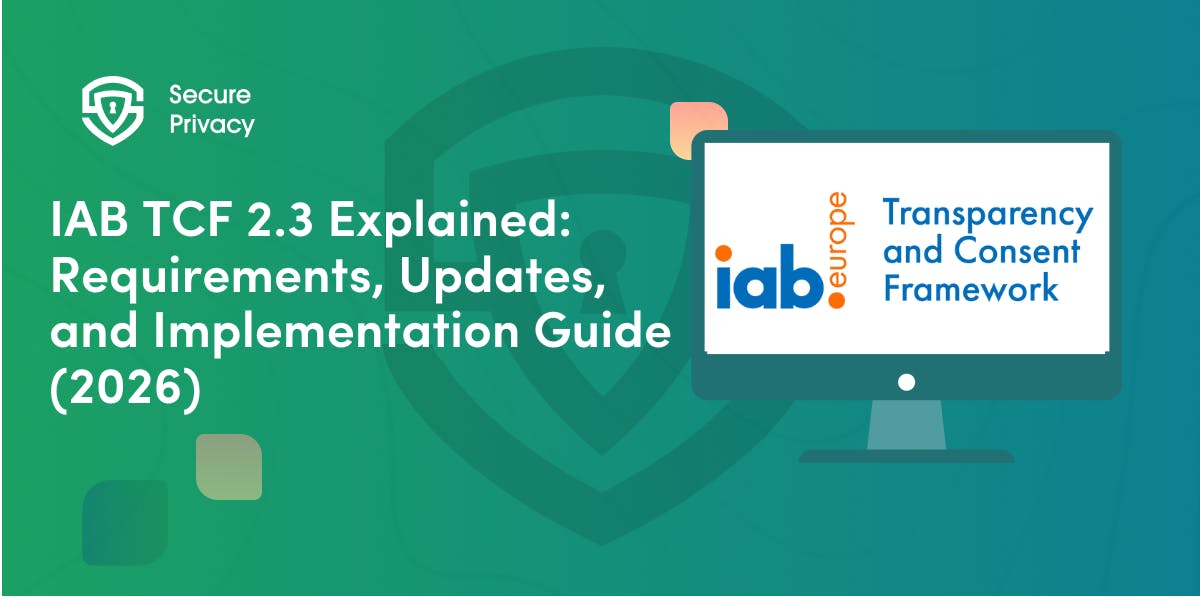Cross-Border Consent Portability: Interoperability Between EU-US-Asia Privacy Regimes
Is your organization prepared to handle consent preferences across jurisdictions? As regulatory fines increase and consumer expectations increase in sophistication, developing effective cross-border consent strategies has become essential for global operations.
The globalization of digital services has made cross-border consent portability a critical challenge for multinational organizations. With diverging privacy frameworks in the EU (GDPR), U.S. (state-level laws like CCPA/CPRA), and Asia (India's DPDPA, China's PIPL), achieving interoperability in consent management requires navigating competing legal philosophies, technical standards, and enforcement mechanisms.
Is your organization prepared to handle consent preferences across jurisdictions? As regulatory fines increase and consumer expectations increase in sophistication, developing effective cross-border consent strategies has become essential for global operations.
The Consent Portability Imperative
Consent portability refers to users' ability to transfer their consent preferences—such as data sharing permissions and opt-in/opt-out choices—across different jurisdictions. Several key factors have made this capability increasingly important:
Global user bases have expanded dramatically, with 63% of Fortune 500 companies now operating in 50 or more countries. This global reach necessitates unified consent frameworks that can function effectively across diverse regulatory environments.
Regulatory pressure continues to intensify, with GDPR fines for cross-border violations reaching €2.9 billion in 2024. Meanwhile, China's Personal Information Protection Law (PIPL) restricts data exports without explicit consent, creating potential conflicts for multinational operations.
Consumer expectations have also evolved, with 81% of users now expecting their consent choices to follow them across borders (Gartner, 2025). This expectation creates both a compliance obligation and a significant opportunity for organizations that can deliver seamless privacy experiences.
Regional Consent Frameworks: Key Divergences
Understanding the fundamental differences between regional privacy regimes is essential for developing effective cross-border consent strategies.
European Union: Setting the Global Standard
The EU's General Data Protection Regulation (GDPR) established the most comprehensive consent requirements, mandating that consent be explicit, granular, and easily revocable. For cross-border transfers, the EU relies on adequacy decisions, Standard Contractual Clauses (SCCs), and Binding Corporate Rules (BCRs) to ensure appropriate safeguards when personal data leaves the region.
GDPR's consent model emphasizes user autonomy and transparency, requiring clear explanations of how personal data will be used. This approach has influenced global standards but creates challenges when interacting with regions that take different approaches to privacy.
United States: A Patchwork Approach
The U.S. lacks a comprehensive federal privacy law, instead relying on state-level legislation such as the California Consumer Privacy Act (CCPA), its successor the California Privacy Rights Act (CPRA), the Texas Data Privacy and Security Act (TDPSA), and the Virginia Consumer Data Protection Act (VCDPA).
These laws typically allow implied consent for many data processing activities, with an emphasis on opt-out mechanisms for data sales and sharing. The U.S. approach generally places less emphasis on advance permission and more on providing users with the ability to withdraw from data processing.
Cross-border mechanisms between the EU and U.S. have been particularly contentious, with the Privacy Shield framework invalidated by the Court of Justice of the European Union. The new Data Privacy Framework (2023) attempts to address these issues but faces ongoing legal challenges.
Asia: Emphasizing Data Sovereignty
Asian privacy frameworks like India's Digital Personal Data Protection Act (DPDPA) and China's Personal Information Protection Law (PIPL) have introduced distinctive approaches that emphasize data sovereignty and localization.
India's DPDPA requires explicit, purpose-specific consent and mandates re-consent when data processors change. China's PIPL imposes strict data localization requirements and introduces the concept of "separate consent" for specific processing activities.
For cross-border transfers, these regions rely on frameworks like the APEC Cross-Border Privacy Rules (CBPR) and ASEAN Model Clauses, though these mechanisms have seen limited adoption compared to their EU counterparts.
Interoperability Challenges
Organizations seeking to implement cross-border consent portability face several significant challenges spanning legal, technical, and enforcement domains.
Legal Misalignments
Fundamental differences in consent philosophies create significant compliance hurdles. While GDPR mandates opt-in for sensitive data processing, U.S. states like Utah allow implied consent for non-sensitive categories. This divergence means that consent collected in one jurisdiction may not satisfy the requirements of another.
Data localization requirements further complicate matters. China's PIPL and Russia's Data Localization Law require domestic storage of personal data, creating direct conflicts with EU and U.S. data export rules that assume greater flexibility in data movement.
Third-party sharing presents another challenge. India's DPDPA requires obtaining fresh consent when data processors change, whereas GDPR permits onward transfers under Standard Contractual Clauses. This discrepancy means that consent management systems must track processor relationships differently across regions.
Technical Barriers
Even when legal requirements can be reconciled, technical incompatibilities often remain. Consent metadata—such as timestamps, purpose codes, and revocation records—frequently use region-specific schemas that don't easily translate across systems.
API fragmentation further complicates integration efforts. U.S. Consent Management Platforms like OneTrust use different standards than China's PIPL-compliant platforms such as Alibaba Cloud's Data Shield. This lack of standardization makes it difficult to create unified consent records that can move seamlessly across borders.
Enforcement Gaps
Enforcement mechanisms vary significantly across regions, creating uncertainty about how consent violations will be handled. EU Data Protection Authorities lack jurisdiction over U.S. state-level violations or China's PIPL enforcement, creating potential blind spots in compliance oversight.
Voluntary frameworks like APEC's Cross-Border Privacy Rules remain limited in reach, with only 9 of 21 member economies adopting these certifications. This patchy adoption makes it difficult to rely on these mechanisms for comprehensive compliance.
Emerging Solutions
Despite these challenges, several promising solutions are emerging to address cross-border consent portability. These approaches combine technological innovation, policy harmonization, and practical implementation strategies.
Global Consent Metadata Standard (GCMS)
The IEEE-led Global Consent Metadata Standard initiative represents one of the most promising developments in consent interoperability. This framework defines universal fields for consent records that can be recognized across different jurisdictions.
Key components of GCMS include purpose codes that map between different regulatory concepts. For example, the standard creates equivalence between GDPR's "legitimate interest" and India's "deemed consent" categories, enabling translation between different legal frameworks.
The standard also incorporates quantum-safe timestamps to ensure long-term auditability across jurisdictions, addressing concerns about future-proofing consent records against emerging computational threats.
Major technology providers have begun adopting this approach, with Microsoft and Tencent now embedding GCMS in their Azure and AliCloud consent management systems. This corporate adoption accelerates standardization and creates practical implementation pathways for organizations using these platforms.
Mutual Recognition Agreements (MRAs)
Bilateral and multilateral agreements between jurisdictions provide another path toward consent interoperability. The EU-U.S. Data Privacy Framework allows Standard Contractual Clauses for data transfers between these regions, though it excludes sensitive data categories due to Federal Trade Commission enforcement limitations.
Regional partnerships are also advancing interoperability, with the ASEAN-EU Digital Partnership piloting alignment between GDPR and Cross-Border Privacy Rules for Southeast Asian e-commerce platforms. These pilot programs create testing grounds for harmonization approaches that might later be expanded more broadly.
While these agreements rarely achieve perfect alignment, they establish sufficient commonality for practical business operations while acknowledging the legitimate differences in regional privacy philosophies.
Consent Passporting
Blockchain-based tools like ConsentChain represent a technological approach to consent portability that empowers individual users. These systems enable users to store their privacy preferences in sovereign digital wallets—typically based in their home jurisdiction.
Through smart contracts, these tools can automatically translate consent preferences to regional formats. For example, they might convert GDPR opt-ins to PIPL's "separate consent" requirements when a European user accesses Chinese services.
Major financial institutions have demonstrated the effectiveness of this approach. HSBC reduced cross-border consent violations by 74% using ConsentChain for retail banking operations spanning APAC and EU markets. This dramatic improvement highlights the potential of technological solutions to address regulatory complexity.
Sector-Specific Progress
Different industries face unique challenges and opportunities in implementing cross-border consent portability. Examining sector-specific developments provides valuable insights into practical implementation approaches.
Healthcare
The healthcare sector has made significant progress in consent interoperability between the EU and U.S., with the Food and Drug Administration and European Medicines Agency now recognizing "qualified consent" for clinical trial data transfers under the Global Consent Metadata Standard.
However, challenges remain in Asian markets. China's PIPL effectively blocks genomic data exports, forcing pharmaceutical companies like Novartis to build local data centers rather than centralizing research data. This fragmentation increases costs and potentially slows medical innovation.
These contrasting developments highlight how sector-specific requirements can either facilitate or hinder consent portability, depending on the specific data types and use cases involved.
Fintech
Financial services have developed innovative solutions to address their unique consent challenges. SWIFT's Consent Gateway allows banks to share Know Your Customer data using aligned purpose codes that satisfy both GDPR and PIPL requirements, reducing redundant consent collection.
Meanwhile, India's Unified Payments Interface faces challenges under the DPDPA's re-consent requirements, which complicate cross-border payment processing. In response, the Reserve Bank of India is testing "consent validity windows" that maintain compliance while enabling efficient transactions.
These financial sector innovations demonstrate how industry-specific solutions can emerge to address the particular consent requirements that affect core business functions.
Case Study: TikTok's Consent Orchestrator
TikTok's global consent system offers a compelling example of pragmatic interoperability that adapts to regional requirements while maintaining a consistent user experience.
The platform implements regional adaptations tailored to local requirements. In the EU, users see granular toggles for algorithm training data in compliance with GDPR. U.S. users experience implied consent for ad targeting in states like Utah and Texas where this approach is permitted. Chinese users encounter localized storage with PIPL's mandatory "separate consent" pop-ups.
Connecting these regional implementations, TikTok's portability engine translates user preferences via GCMS when accounts migrate across regions. This ensures that an EU user traveling to Singapore maintains appropriate privacy protections without a degraded experience.
The results have been impressive, with TikTok achieving a 92% reduction in Data Protection Authority cross-border complaints since implementing this system in 2024. This outcome demonstrates that thoughtful implementation of consent portability can deliver both compliance benefits and improved user experiences.
Future Outlook
The landscape of cross-border consent portability continues to evolve rapidly, with several key developments anticipated in the coming years.
Efforts toward global standardization are accelerating, with a UN Global Consent Convention draft expected in 2026. This initiative aims to harmonize core principles across more than 50 nations, potentially creating a more consistent foundation for consent portability.
Technological innovations will further transform consent management. AI-mediated consent systems using large language models like GPT-5 are expected to automatically generate jurisdiction-specific consent language that maintains consistency across regions while satisfying local requirements.
The consent management market itself is evolving, with Consent-as-a-Service (CaaS) providers like Ethyca offering API-driven portability solutions accessible to small and medium enterprises. This democratization of sophisticated consent technology will likely accelerate adoption across market segments.
Strategic Recommendations
Organizations seeking to implement effective cross-border consent portability should consider several strategic approaches:
First, adopt GCMS early to preempt regional audit issues by standardizing consent metadata across your operations. This proactive standardization creates a foundation for interoperability regardless of which specific mechanisms eventually become dominant.
Second, leverage hybrid storage approaches that keep raw data localized while sharing consent metadata globally. This balanced approach satisfies data localization requirements while enabling unified consent management.
Finally, pressure-test your consent system using Binding Corporate Rules as a bridge until Mutual Recognition Agreements mature. BCRs provide a comprehensive framework for data transfers that can help identify potential compliance gaps before they become regulatory issues.
The Path Forward
While full interoperability remains years away, organizations that implement GCMS and blockchain passporting now will gain significant advantages. These early adopters will not only avoid their share of 2025's projected $12 billion in cross-border consent fines (IDC, 2025) but will also build valuable experience with technologies and approaches likely to become industry standards.
The future belongs to consent systems as borderless as the data they protect. By investing in interoperability today, forward-thinking organizations can transform a complex compliance challenge into a strategic advantage that enhances both regulatory standing and customer experience across global markets.
Get Started For Free with the
#1 Cookie Consent Platform.
No credit card required

DSAR Tools Explained: Best Software for Automating Privacy Requests
You're drowning in data subject access requests. Manual searches through dozens of systems miss regulatory deadlines and expose organizations to fines starting at $2,500 per violation. The solution? DSAR tools — purpose-built software that automates the entire process of responding to data subject access requests, from intake to delivery.
- Legal & News

IAB TCF 2.3 Explained: Requirements, Updates, and Implementation Guide (2026)
Your ad revenue dropped 40% overnight. Google stopped bidding on your inventory. Your DSP partners flagged your traffic as non-compliant. The culprit? An outdated TCF 2.2 consent string after the February 2026 enforcement deadline.
- Legal & News
- Cookie Consent

The SaaS DPA Guide: GDPR Requirements, Subprocessors, and Automation
Your enterprise deal stalled in legal review for three weeks while procurement demands a comprehensive data processing agreement, your legal team scrambles to understand GDPR requirements, and your sales team watches the quarter-end deadline approach with increasing anxiety.
- Legal & News
- Data Protection

